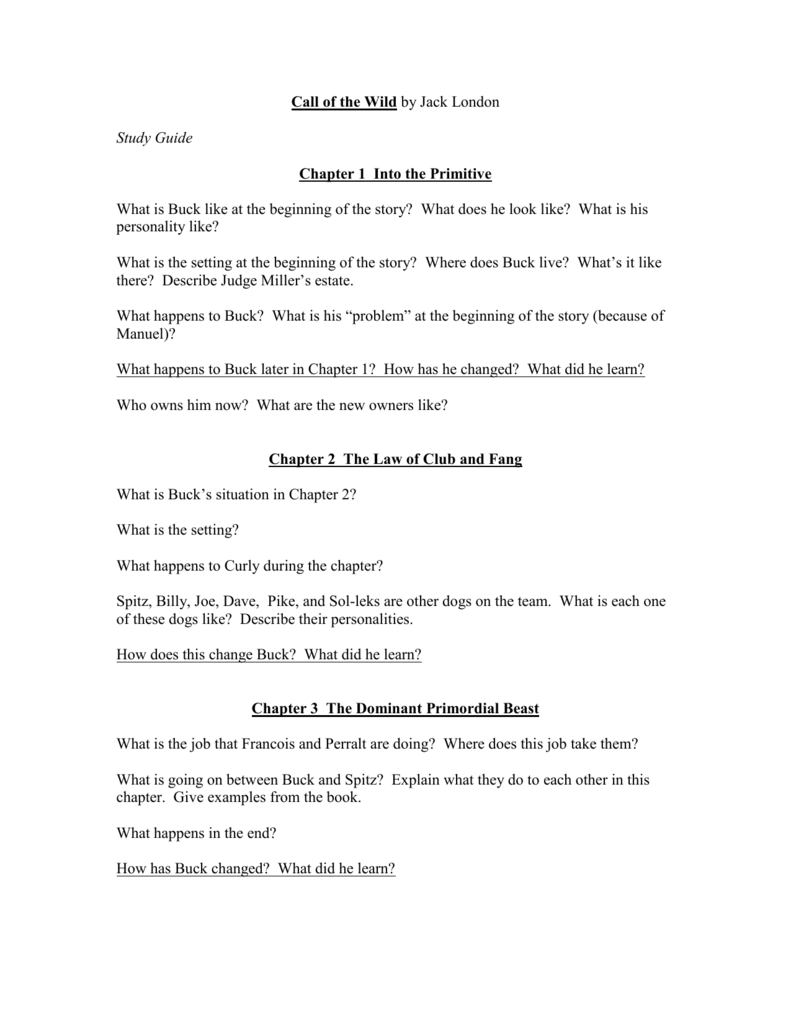Answers For Into The Wild Study Guide

Teaching Into the WildThe Into the Wild lesson plan contains a variety of teaching materials that cater to all learning styles. Insideyou'll find 30 Daily Lessons, 20 Fun Activities, 180 Multiple Choice Questions, 60 Short Essay Questions, 20 Essay Questions,Quizzes/Homework Assignments, Tests, and more. The lessons and activities will help students gain an intimate understandingof the text, while the tests and quizzes will help you evaluate how well the students have grasped the material.Target Grade: 7th-12th (Middle School and High School)Length of Lesson Plan: Approximately 160 pages.
Page count is estimated at 300 words per page.Length will vary depending on format viewed.Browse The Into the Wild Lesson Plan:.Full Lesson Plan Overview Completely Customizable!The Into the Wild lesson plan is downloadable in PDF and Word. The Word file is viewable with any PC or Macand can be further adjusted if you want to mix questions around and/or add your own headers for things like 'Name,'Period,' and 'Date.' The Word file offers unlimited customizing options so that you can teach in the most efficientmanner possible. Once you download the file, it is yours to keep and print for your classroom.Lesson Plan CalendarsThe Lesson Plan Calendars provide daily suggestions about what to teach. They include detailed descriptions of whento assign reading, homework, in-class work, fun activities, quizzes, tests and more. Use the entire Into the Wildcalendar, or supplement it with your own curriculum ideas.
Not only does he die before he can answer his family's questions or explain in his few journal entries exactly why he has headed into the wild, but the extreme.
Calendars cover one, two, four, and eight week units.Determine how long your Into the Wild unit will be, then use one of the calendars provided to plan out your entirelesson. Chapter AbstractsChapter abstracts are short descriptions of events that occur in each chapter of Into the Wild. They highlight majorplot events and detail the important relationships and characteristics of important characters. The Chapter Abstractscan be used to review what the students have read, or to prepare the students for what they will read. Hand theabstracts out in class as a study guide, or use them as a 'key' for a class discussion.
They are relatively brief,but can serve to be an excellent refresher of Into the Wild for either a student or teacher. Character and Object DescriptionsCharacter and Object Descriptions provide descriptions of the significant characters as well as objects and placesin Into the Wild. These can be printed out and used as an individual study guide for students, a 'key' for leadinga class discussion, a summary review prior to exams, or a refresher for an educator. The character and object descriptionsare also used in some of the quizzes and tests in this lesson plan. The longest descriptions run about 200 words.They become shorter as the importance of the character or object declines. Daily LessonsThis section of the lesson plan contains 30 Daily Lessons. Daily Lessons each have a specific objective and offerat least three (often more) ways to teach that objective.
Lessons include classroom discussions, group and partneractivities, in-class handouts, individual writing assignments, at least one homework assignment, class participationexercises and other ways to teach students about Into the Wild in a classroom setting. You can combine daily lessonsor use the ideas within them to create your own unique curriculum. They vary greatly from day to day and offer anarray of creative ideas that provide many options for an educator. Fun Classroom ActivitiesFun Classroom Activities differ from Daily Lessons because they make 'fun' a priority.
The 20 enjoyable, interactiveclassroom activities that are included will help students understand Into the Wild in fun and entertaining ways.Fun Classroom Activities include group projects, games, critical thinking activities, brainstorming sessions, writingpoems, drawing or sketching, and countless other creative exercises. Many of the activities encourage students tointeract with each other, be creative and think 'outside of the box,' and ultimately grasp key concepts from thetext by 'doing' rather than simply studying. Fun activities are a great way to keep students interested and engagedwhile still providing a deeper understanding of Into the Wild and its themes.
Essay Questions/Writing AssignmentsThese 20 Essay Questions/Writing Assignments can be used as essay questions on a test, or as stand-alone essay topicsfor a take-home or in-class writing assignment on Into the Wild. Students should have a full understanding of the unitmaterial in order to answer these questions. They often include multiple parts of the work and ask for a thoroughanalysis of the overall text. They nearly always require a substantial response. Essay responses are typically expectedto be one (or more) page(s) and consist of multiple paragraphs, although it is possible to write answers more briefly.These essays are designed to challenge a student's understanding of the broad points in a work, interactions amongthe characters, and main points and themes of the text.
But, they also cover many of the other issues specific tothe work and to the world today. Short Essay QuestionsThe 60 Short Essay Questions listed in this section require a one to two sentence answer.
They ask students to demonstratea deeper understanding of Into the Wild by describing what they've read, rather than just recalling it. The shortessay questions evaluate not only whether students have read the material, but also how well they understand andcan apply it. They require more thought than multiple choice questions, but are shorter than the essay questions.
Multiple Choice QuestionsThe 180 Multiple Choice Questions in this lesson plan will test a student's recall and understanding of Into the Wild.Use these questions for quizzes, homework assignments or tests. The questions are broken out into sections, so theyfocus on specific chapters within Into the Wild. This allows you to test and review the book as you proceed throughthe unit. Typically, there are 5-15 questions per chapter, act or section. Evaluation FormsUse the Oral Reading Evaluation Form when students are reading aloud in class. Pass the forms out before you assignreading, so students will know what to expect. You can use the forms to provide general feedback on audibility,pronunciation, articulation, expression and rate of speech.

You can use this form to grade students, or simply commenton their progress.Use the Writing Evaluation Form when you're grading student essays. This will help you establish uniform criteriafor grading essays even though students may be writing about different aspects of the material. By following thisform you will be able to evaluate the thesis, organization, supporting arguments, paragraph transitions, grammar,spelling, punctuation, etc. Of each student's essay. Quizzes/Homework AssignmentsThe Quizzes/Homework Assignments are worksheets that can be used in a variety of ways.
They pull questions from themultiple choice and short essay sections, the character and object descriptions, and the chapter abstracts to createworksheets that can be used for pop quizzes, in-class assignments and homework. Periodic homework assignments andquizzes are a great way to encourage students to stay on top of their assigned reading. They can also help you determinewhich concepts and ideas your class grasps and which they need more guidance on. By pulling from the different sectionsof the lesson plan, quizzes and homework assignments offer a comprehensive review of Into the Wild in manageableincrements that are less substantial than a full blown test.
TestsUse the Test Summary page to determine which pre-made test is most relevant to your students' learning styles. Thislesson plan provides both full unit tests and mid-unit tests. You can choose from several tests that include differingcombinations of multiple choice questions, short answer questions, short essay questions, full essay questions,character and object matching, etc. Some of the tests are designed to be more difficult than others. Some have essayquestions, while others are limited to short-response questions, like multiple choice, matching and short answerquestions. If you don't find the combination of questions that best suits your class, you can also create your owntest on Into the Wild. Create Your Own Quiz or TestYou have the option to Create Your Own Quiz or Test.
If you want to integrate questions you've developed for yourcurriculum with the questions in this lesson plan, or you simply want to create a unique test or quiz from the questionsthis lesson plan offers, it's easy to do. Cut and paste the information from the Create Your Own Quiz or Test pageinto a Word document to get started.
Scroll through the sections of the lesson plan that most interest you and cutand paste the exact questions you want to use into your new, personalized Into the Wild lesson plan.
